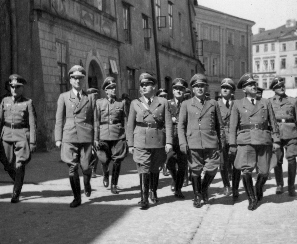Holocaust Education & Archive Research Team |
Aktion Reinhard
A-R Leadership A-R Articles
Action Erntefest Modern Research
| |||
Introduction to Aktion Reinhard
The term Aktion Reinhard was the code name for the extermination of Polish Jewry in the Generalgouvernement during the years 1942 and 1943. It should be noted that there were many different variations of this term, including Einsatz Reinhardt, Sondereinsatz Reinhardt, and Aktion Reinhard. It is widely accepted that the code name was used in honour and remembrance of Reinhard Heydrich, SS- Gruppenführer, who was the coordinator of the `Final Solution of the Jewish Question’. Heydrich died of his wounds on 4 June 1942, following a daring attack on 27 May 1942 by two `Free’ Czech agents who had been trained in England. A letter has recently been discovered dated 6 June 1942 (two days after Reinhard Heydrich died) to SS-und Polizeiführer Reinhardt, Chopin Street 27 Lublin, possibly the first known mention of the term. The leader of Aktion Reinhard was SS- Brigadeführer Odilo Globocnik, the SS and Police Leader for the Lublin district, who was appointed to this role by Heinrich Himmler, the Reichsführer-SS. This programme had two distinct aims; firstly, the deportation and physical destruction of the Jewish people in the Generalgouvernement, and secondly, the collection of the victim’s valuables and possessions, from their houses to the shoes on their feet. To achieve this aim three death camps were built, at Belzec, Sobibor, and Treblinka. The three camps were built in remote, wooded, and sparsely populated areas in the far eastern region of Poland. Good rail connections were also a factor in deciding the location of the camps, as the majority of victims arrived by train. The death camps were all built, run and staffed on similar lines, and after the physical destruction of the Jews, their clothing, goods and valuables were shipped to Lublin, either to Chopin Street or the Bekleidungswerke hangers at the Old Lublin Airfield. The progress of the mass murder programme was carefully monitored by the Germans. Two telegrams from Höfle, the Aktion Reinhard Chief of Staff, sent to Adolf Eichmann (incomplete) and to SS- Obersturmbannführer Heim in Krakow on 11 January 1943, were intercepted by British Intelligence using a replica `enigma’ machine, manufactured by the Polish Intelligence Service. The telegrams indicated how many people had been killed in the Aktion Reinhard programme. The telegram has some typing errors, but the overall figure of 1,274,166 liquidated to 31 December 1942 is crucial evidence.
Aktion Reinhard, one of the most murderous programmes in history, was staffed by a relatively small number of people in comparison to the number of victims. The key players in the administration of this mass murder process were Hermann Höfle, Christian Wirth, Richard Thomalla, Georg Michalsen, Hermann Worthoff, and Amon Göth. During the deportations to the death camps or the liquidation of ghettos in general, there was a special group of SS-men in every district of the Generalgouvernement who cooperated with Aktion Reinhard Headquarters in Lublin. Each unit consisted of 10-20 SS-men connected with the local branch of the Gestapo, particularly with the department responsible for Jewish affairs. These SS-men were responsible for the preparation of the deportations, as well as the selections in the ghettos and the actual deportations themselves. The SS also cooperated extensively with representatives of the German civil administration, such as the work offices (Arbeitsamt) and railway offices in relevant towns. In some towns the members of the German civil administration also participated in the actual deportations and liquidation of the ghetto. Comprehensive cooperation also existed between the SS and units of the police. Functioning at district level, there was this kind of special SS unit responsible for local deportations in every larger town. Globocnik was promoted and transferred to Trieste as SSPF Kustenland in August / September 1943 and took a number of key Aktion Reinhard personnel with him, such Christian Wirth, Franz Stangl, Franz Reichleitner, Gottlieb Hering, Kurt Franz, Ernst Lerch and others. Jewish Labour Camps at Budzyn, the Old Airfield Lublin, Poniatowa, Trawniki, and the SS training camp for foreign auxiliaries at Trawniki, were all associated with Aktion Reinhard. Globocnik handed over control of these camps, which had been managed under the banner of OSTI (East Industries Limited), to Oswald Pohl of the SS Economic and Administrative Main Office (SS - Wirtschafts- und Verwaltungshauptamt: WVHA) on 22 October 1943. In addition to the labour camps in the Lublin district, work camps in other districts like Janowska in Lwow or Szebnie in the Krakow district were also connected with Aktion Reinhard.
On 22 September 1943 Himmler wrote to Globocnik requesting him to submit a summary report on Aktion Reinhard covering the economic achievements and assets realised. On 4 November 1943 and in a subsequent comprehensive report dated 5 January 1944, Globocnik supplied a detailed financial accounting to Himmler, confirming the termination of the operation. Himmler replied on 30 November 1943, thanking Globocnik for his report, accepting the termination of Aktion Reinhard, and thanking him for the great and unique services he had performed for the entire German people in carrying out the Aktion. Aktion Reinhard was responsible for the mass murder of approximately 1.7 million Jews, and the theft of a final amount of Jewish property (according to Globocnik’s figures) amounting to RM 178, 745,960 , which in today’s terms is equivalent to approximately 800m US Dollars. The true yield had been much greater. With the cessation of Aktion Reinhard in November 1943 the majority of the staff was transferred to Italy, where some were promoted and given medals. As a group they continued to murder Jews, albeit on a much reduced scale, and to fight partisans. Sources: Yitzhak Arad, Belzec, Sobibor and Treblinka , Indiana University Press 1987. National Archives Kew SJ Archive Akcja “Reinhardt”. Zagłada Żydów w Generalnym Gubernatorstwie. Ed. by Dariusz Libionka, Warszawa 2004.
Copyright. SC/RK HEART 2007
|


